#paratypothorax
Explore tagged Tumblr posts
Text
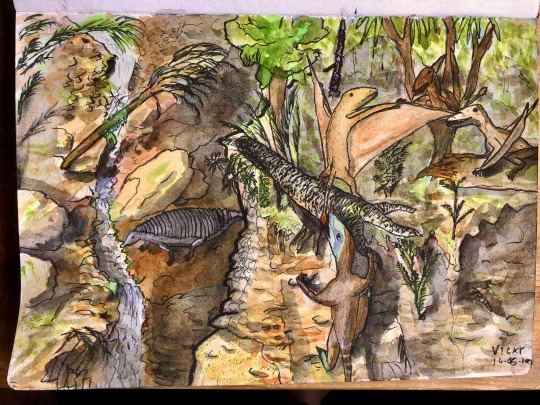
A Peteinosaurus shows off on a Williamsonia atop a small overgrown cliff, unaware of the Procompsognathus climbing the cliff to sneak up on him. Behind and below them, a Paratypothorax has come to her favourite stream to drink.
#peteinosaurus#procompsognathus#paratypothorax#pterosaur#dinosaur#coelophysid#theropod#aetosaur#pseudosuchian#triassic#paleoart#williamsonia#my art#palaeoblr#watercolour#cliffs#mountains
134 notes
·
View notes
Text




Although they are often overshadowed by dinosaurs in people’s imagination of the past, the crocodile line reptiles, or pseudosuchians, dominated the Triassic in many ways. These two are Batrachotomus, an agile carnivore, and Paratypothorax, a heavily armoured herbivorous aetosaur. Though crocodiles are their closest living relatives, neither of them lived in the water. Although the Triassic is often called the first part of the ‘age of dinosaurs’, the swift little dinosaurs of the age would have lived in the shadow of pseudosuchians like these, until the end-Triassic mass extinction changed everything.
#pseudosuchian#batrachotomus#paratypothorax#aetosaur#triassic#palaeoblr#i love the metallic reconstruction of the paratypothorax
12 notes
·
View notes
Text
Garzapelta: The Convergent Aetosaur
Our second pseudosuchian of 2024 couldn't be any more different from the first. While the first genus named this year was Varanosuchus, a small, agile atoposaurid from the Cretaceous, our second genus is Garzapelta (Garza County Shield), a large lumbering aetosaur, basically the ankylosaur of the Triassic.
If you remember the two posts on aetosaurs I did last year, you probably remember how osteoderms are super diagnostic for these guys and how the material doesn't need to be all that exciting to represent a new genus. In the case of Garzapelta its kind of an intermediate. It's better than the handfull of osteoderms we got for Venkatasuchus and Kryphioparma but its still mostly just osteoderms and some ribs (and a single toe bone).

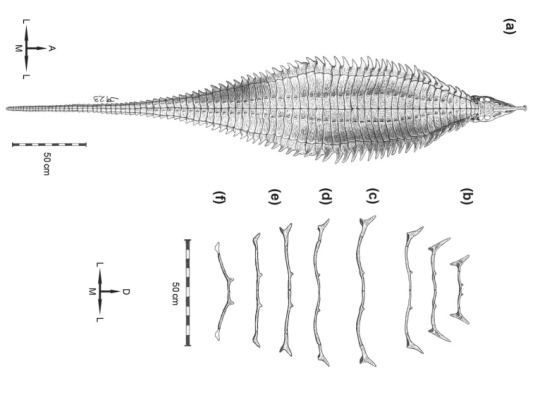
Now the thing that stands out about Garzapelta is the specific combination of characters displayed by the osteoderms. So if you take a step back and look at aetosaurs as a whole, you'll see two big groups that split off from one another. The stagonolepoids, which eventually gave rise to the overly spiky desmatosuchines, and the aetosaurines, which gave rise to some really wide paratypothoracines. Shown below Desmatosuchus and Paratypothorax (not to scale), taken from Martz et al. 2013 and Heckert et al. 2010
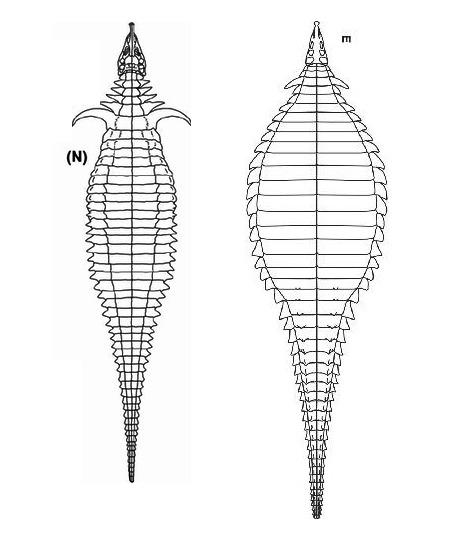
But this doesn't yet say why Garzapelta is special. Well you see. We got both the paramedian osteoderms (the central two rows) and the lateral osteoderms (those spikes on the side). Now, the lateral osteoderms are morphologically really similar to those of desmatosuchines, HOWEVER, the paramedian osteoderms more closely resemble those of paratypothoracines. This is so extreme that when writing the paper, Reyes and colleagues did separate phylogenetic analysis for both osteoderm types. And as you might have guessed, when just looking at the laterals it was recovered as a desmatosuchine, but when looking at the paramedians it was recovered as a paratypothoracine (or rather something close to said groups). And when looking at both at the same time....well still a desmatosuchine.
Ironically, despite this, the authors don't think it was a desmatosuchine. Instead, the way the lateral and paramedian osteoderms connect is way more similar to paratypothoracines and ultimately the authors argue that its way more likely that the shape of the lateral osteoderms is the thing that evolved convergently. This whole situation does however highlight a major thing. Current datasets aren't really ready to deal with convergence like this.
And thats all I got to say about this one. Not as extensive as little Varanosuchus I know, but its surprisingly much given its just a bunch of osteoderms and not much in terms of skull remains or anything like that.
64 notes
·
View notes
Text
weird question: does anyone know an artist that does commissions that draws dinosaurs? specifically a paratypothorax? i need it for my daughter for christmas.
30 notes
·
View notes
Text
One paleoart for each period since the Cryogenian
Thanks to the timeline on my walls that I've been trying to fill in with my art, I have now reached the point where I've done paleoart for every single period of the Phanerozoic, plus the Ediacaran and Cryogenian! That is to say, every period of the last 700 million years. So with that milestone, I thought it'd be fun to go through those periods in order and show off one paleoart of mine for each!
Cryogenian
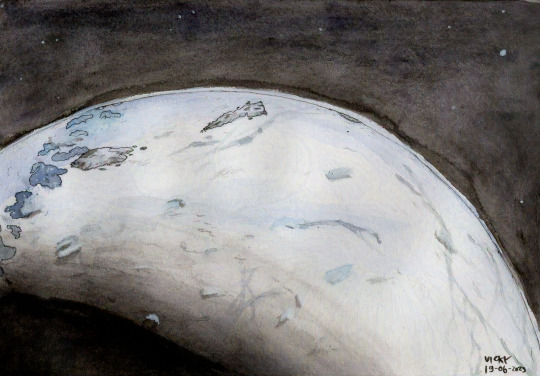
In the Cryogenian, the Earth completely froze over. Twice! Life wasn't much to look at yet, but I enjoyed drawing what our planet might have looked like at the time. The girdle of lakes at the left is the equator, which may have had ice-free patches.
Ediacaran
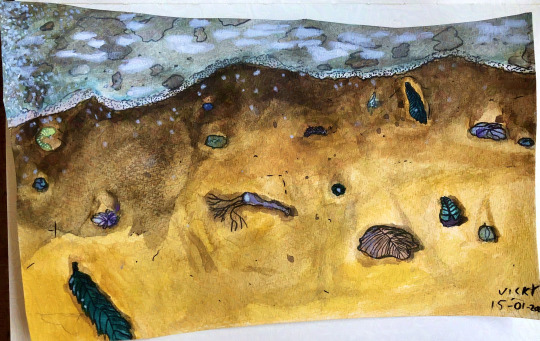
When the ice retreated, animals first began to blossom into their endless forms most beautiful. Ediacaran life was strange and quite unlike the creatures that would come later, but it was nonetheless an incredibly important chapter in life's history. Here we see the Ediacaran weirdos washing up on shore after a storm.
Cambrian

The Cambrian explosion brought much more recognisable creatures. But one thing that's easy to miss is that they were all tiny! All of them? No, Anomalocaris was, with a length of about 40 cm, the dragon of the Cambrian.
Ordovician

Life continued to diversify in the Ordovician, and among this diversity were the cephalopods. They produced the largest animals yet to exist, the orthocones, who hung vertically in the water column and decended upon their prey like a claw game.
Silurian
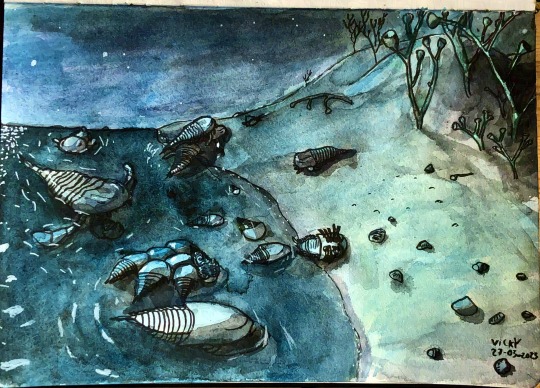
Although fungi and bacteria had already made forays onto the land deep in the past, things began to get busier there in the Silurian. But these horseshoe crabs, and their larger cousins the sea scorpions, have not come to the shore to stay, but to mate and lay eggs. Unfortunately for the horseshoe crabs, they have come to the very same shore.
Devonian
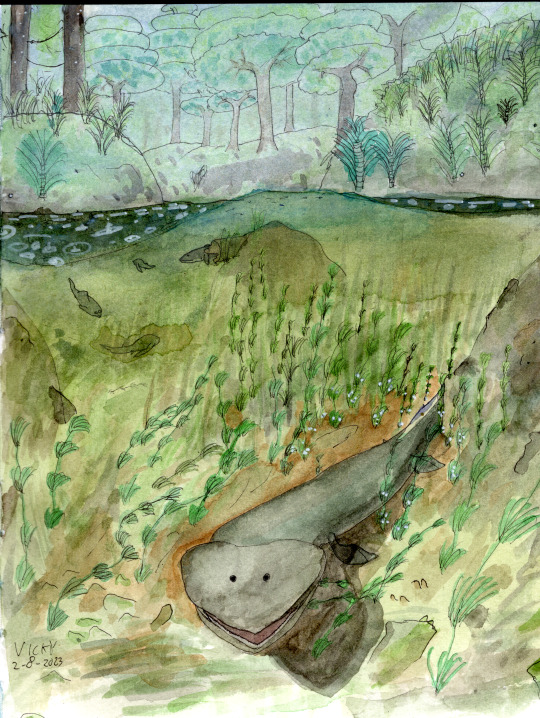
Our own vertebrate ancestors, like Tiktaalik, were pretty late to the party, only taking their first steps on land in the late Devonian. That's no knock against them - there was plenty to do underwater! This Tiktaalik is busy guarding his eggs while his mate is busy hunting, for example. Who has time to step on land?
Carboniferous
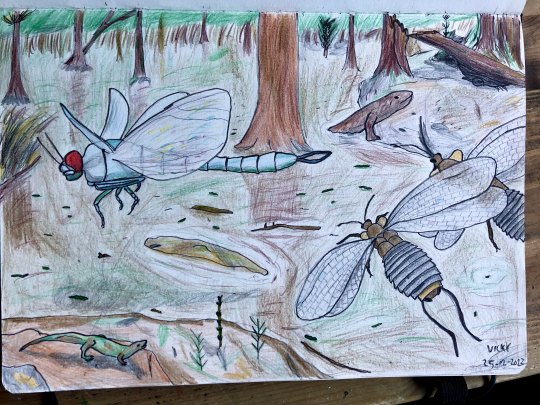
The end of the Carboniferous saw some quite large bugs, like these two Mazothairos chasing off an interloping Meganeura. They're representatives of a pretty interesting group of basal insects called the Palaeodictyoptera, who have a set of weird little extra wings on their thorax.
Permian

Among the many fantastic creatures of the Permian were our own cousins, the synapsids, like these lovey-dovey Moschops. As you can see, this picture and the previous one are done in coloured pencils instead of watercolour, because they're the oldest images I'm including in this post. I only very rarely used watercolours before this year. I think it means I should do some more Permian art, it's such a cool and underexposed period.
Triassic
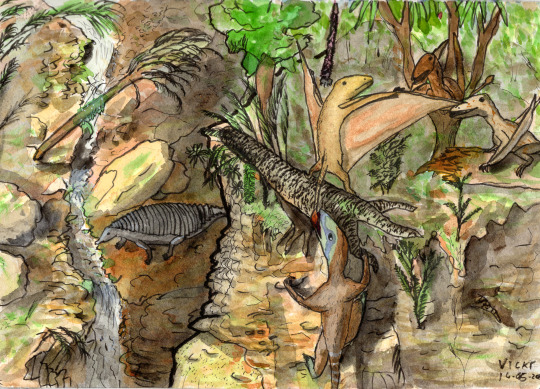
One mass extinction later, the archosaurs are diversifying all over Triassic Pangaea. Here we have the three main groups of them: Paratypothorax, a pseudosuchian in the background; Peteinosaurus, a pterosaur on top of the cliff; and Procompsognathus, a dinosaur climbing the cliff.
Jurassic

I had three different option for Jurassic paleoart to showcase, so I picked the most experimental one. These backlit insects are not butterflies, but kalligrammatids, a group of large-winged neuroptera, some of which even mimicked maniraptoran dinosaurs like this iridescent Caihong with their patterns.
Cretaceous
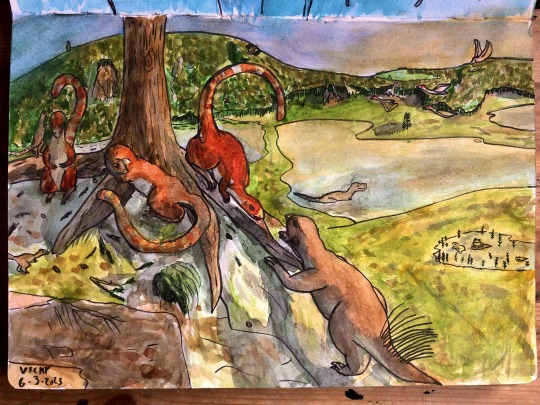
The Cretaceous featured some of life's most gorgeous crescendos of diversity, like the Yixian formation, where a Psitaccosaurus wants to visit the favourite tree of a group of Sinosauropteryxes, who are having none of it. This is still one of my favourite pieces I've ever drawn.
Paleogene
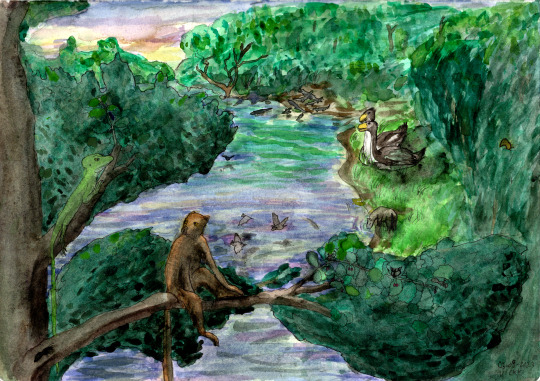
The Paleogene featured some of the highest global temperatures of all time, leading to tropical climates all over the planet, including at this lake in what will one day be Messel, Germany. Darwinius, a close cousin to our own ancestors, is having a staredown with the lizard Geiseltaliellus.
Neogene

The world turned colder and dryer in the Neogene, leading to the spread of large grasslands, like these South American ones. Phorusracos, a large terror bird, has caught a Thoatherium on the edge of the forest they both live in. South America was an isolated continent for the duration of the Neogene, leading to a quite unique fauna.
Quaternary

The Quaternary, our current period, is marked by the cycle of ice ages regularly freezing the northern hemisphere. But even during the ice ages, spring would come to the mammoth steppes, and these steppe mammoths are happy to celebrate its coming with a bath in the river.
#paleoart#my art#palaeoblr#timeline#no i am not gonna tag everything in it#the pictures should all work as links to the individual posts of these pieces#cw: animal death#cw: bugs#cw: parasites#cw: blood
309 notes
·
View notes
Text
Closer looks at the two sides on their own:



A Peteinosaurus shows off on a Williamsonia atop a small overgrown cliff, unaware of the Procompsognathus climbing the cliff to sneak up on him. Behind and below them, a Paratypothorax has come to her favourite stream to drink.
#peteinosaurus#procompsognathus#paratypothorax#pterosaur#dinosaur#coelophysid#theropod#aetosaur#pseudosuchian#triassic#paleoart#my art#palaeoblr#not crazy about how the full image came out#but each half on their own is kind of nice
134 notes
·
View notes
Text
I got the inspiration for this watercolour while hiking in Switzerland. Coming across landscapes like this, it was easy to imagine pterosaurs living on the cliffs. It ended up being set in Switzerland too: it turns out early pterosaurs were pretty much restricted to the part of Pangaea that would become Europe during the Triassic!

A Peteinosaurus shows off on a Williamsonia atop a small overgrown cliff, unaware of the Procompsognathus climbing the cliff to sneak up on him. Behind and below them, a Paratypothorax has come to her favourite stream to drink.
My Ko-fi
#peteinosaurus#procompsognathus#paratypothorax#pterosaur#dinosaur#coelophysid#theropod#aetosaur#pseudosuchian#triassic#paleoart#williamsonia#my art#palaeoblr
134 notes
·
View notes